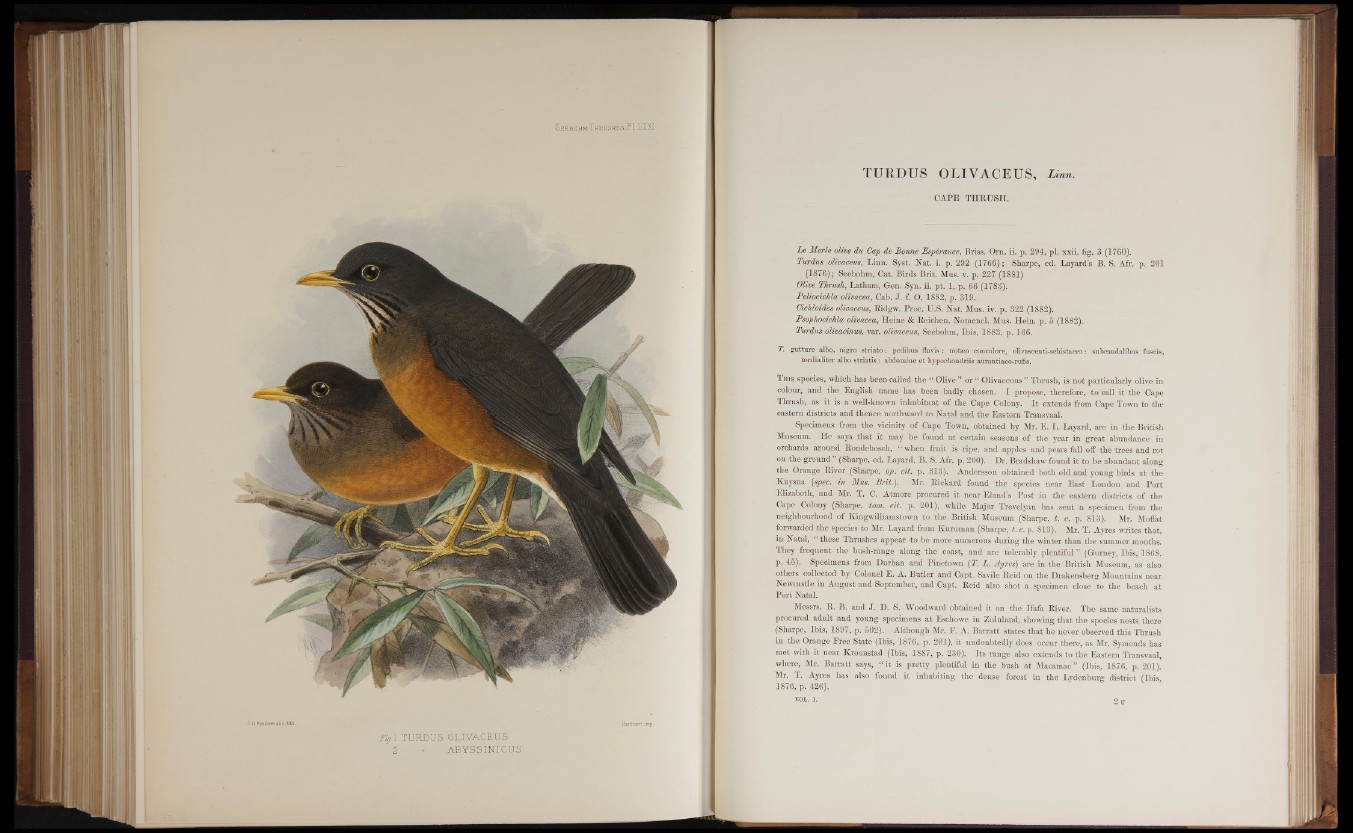
Fig 1. TU-RDUS O L IV A C EU S .
'Si.; . ’ A B Y S S IN IC U S
TURDUS OLIVACEUS, Unn.
CAPE THKTJSH.
Le Merle olive du Cap de Bonne Espérance, Briss. Orn. ii. p. 294, pi. xxii. fig. 3 (1760).
Turdus olivaceus, Linn; Syst. Nat. i. p. 292 (1766) ; Sharpe, ed. Layard’s B. S. Afr. p. 201
(1876); Seebohm, Cat. Birds Brit. Mus. y . p. 227 (1881)
Olive Thrush, Latham, Gen. Syn. ii. pt. 1, p. 66 (1783).
Peliocichla'olivacea, Cab. J. f. O. 1882, p. 319.
Oichloides olivaceus, Ridgw. Proc. U.S. Nat. Mus. iv. p. 322 (1882).
Psophocichla olivacea, Heine & Reichen. Nomencl. Mus. Hein. p. 5 (1882).
Turdus olivacinus, var. olivaceus, Seebohm, Ibis, 1883, p. 166.
T. gutture albo, nigro striato : pedibus flavis : notseo concolore, olivascenti-schistaceo : subcaudalibus fuscis,
medialiter albo striatis : abdomine et hypochondriis aurantiaco-rufis.
T his species, which has been called the “ Olive ” or “ Olivaceous ” Thrush, is not particularly olive in
colour, and the English name has been badly chosen. I propose, therefore, to call it the Cape
Thrush, as it is a well-known inhabitant of the Cape Colony. It extends from Cape Town to the
eastern districts and thence northward to Natal and the Eastern Transvaal.
Specimens from the vicinity of Cape Town, obtained by Mr. E. L. Layard, are in the British
Museum. He says that it may be found at certain seasons of the year in great abundance in
orchards around Rondebosch, “ when fruit is ripe, and apples and pears fall off the trees and rot
on the ground ’ (Sharpe, ed. Layard, B. S. Afr. p. 200). Dr. Bradshaw found it to be abundant along
the Orange River (Sharpe, op. cit. p. 313). Andersson obtained both old and young birds at the
Knysna (spec, in Mus. Brit.). Mr. Rickard found the species near East London and Port
Elizabeth, and Mr. T. C. Atmore procured it near Eland’s Post in the eastern districts of the
Cape Colony (Sharpe, tom. cit. p. 201), while Major Trevelyan has sent a specimen from the
neighbourhood o f Kingwilliamstown to the British Museum (Sharpe, t. c. p. 813). Mr. Moffat
forwarded the species to Mr. Layard from Kuruman (Sharpe, t. c. p. 813). Mr. T. Ayres writes that,
in Natal, “ these Thrushes appear to be more numerous during the winter than the summer months.
They frequent the bush-range along the coast, and are tolerably plentiful ” (Gurney, Ibis, 1868,
p. 45). Specimens from Durban and Pinetown {T. L. Ayres) are in the British Museum, as also
others collected by Colonel E. A. Butler and Capt. Savile Reid on the Drakensberg Mountains near
Newcastle in August and September, and Capt. Reid also shot a specimen close to the beach at
Port Natal.
Messrs. R. B. and J. D. S. "Woodward obtained it on the Ifafa River. The same naturalists
procured adult and young specimens at Eschowe in Zululand, showing that the species nests there
(Sharpe, Ibis, 1897, p. 502). Although Mr. P. A. Barratt states that he never observed this Thrush
in the Orange Free State (Ibis, 1876, p. 201), it undoubtedly does occur there, as Mr. Symonds has
met with it near Kroonstad (Ibis, 1887, p. 230). Its range also extends to the Eastern Transvaal,
where, Mr. Barratt says, “ it is pretty plentiful in the bush at Macamac ” (Ibis, 1876, p. 201).
Mr. T. Ayres has also found it inhabiting the dense forest in the Lydenburg district (Ibis
1876, p. 426).
vol. i . 2 u